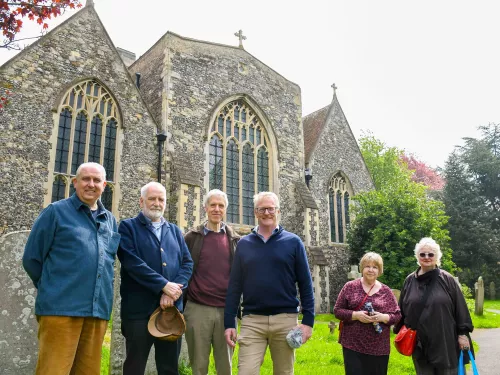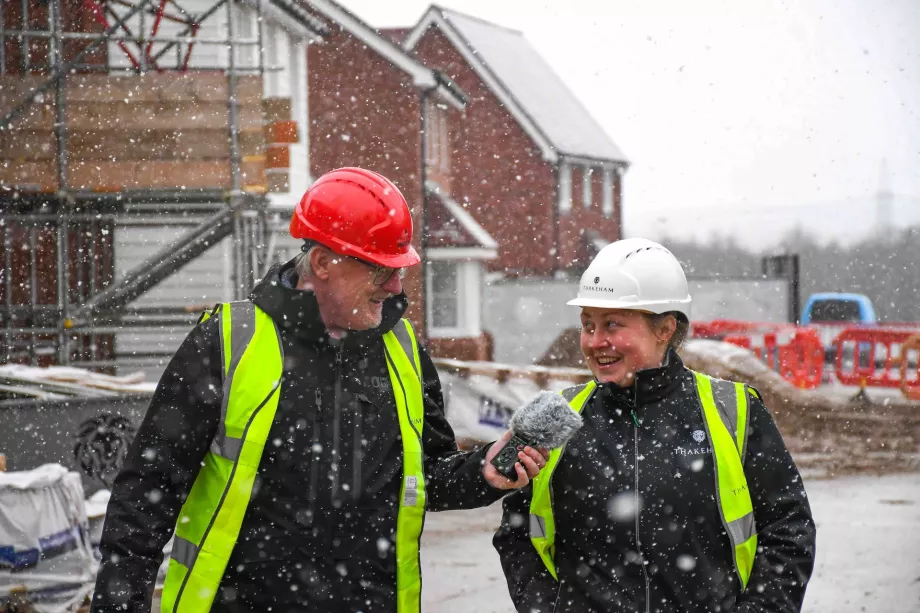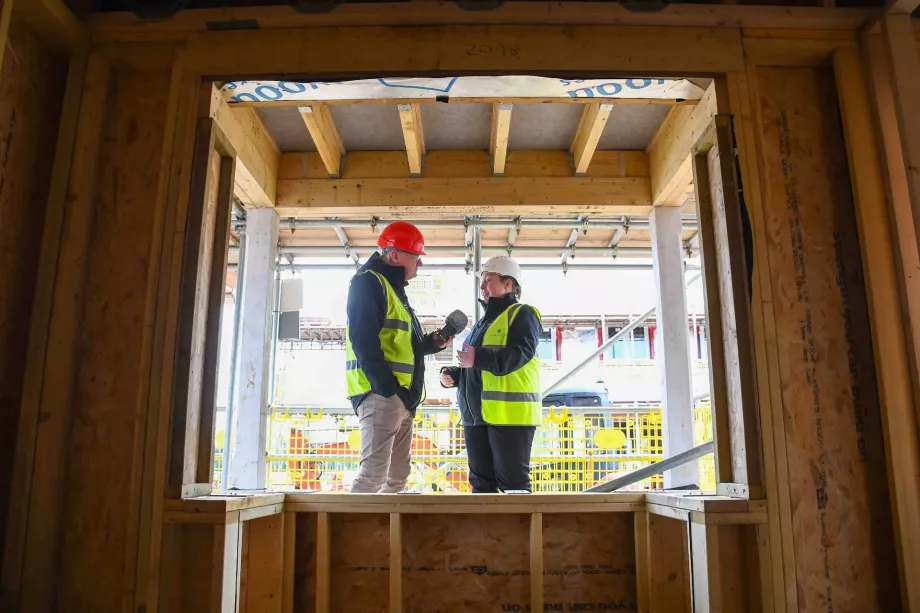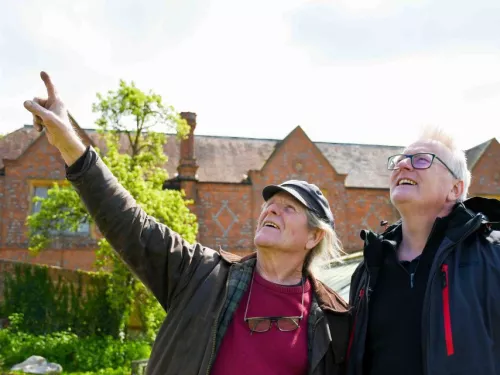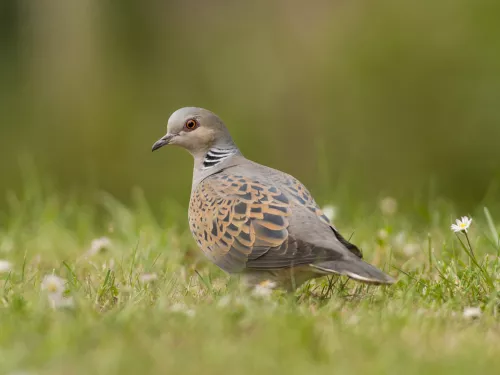Josie Cadwallader-Hughes: No. So this is a timber-frame house. Now, normally what we would do is there'd be this skin of concrete blocks, which are pretty carbon intensive, quite labour intensive, having to lay them one by one. And by building with timber frame, we drop what's called the ‘embodied carbon emissions’. So that's everything that goes into, like, creating that material before it arrives to our construction site. It means it's quicker, it's actually easier for us to jam much more insulation in it and therefore make it more energy efficient over time.
Rob Smith: So, if this is cheaper, quicker, and easier to build and better insulated, why aren't all houses made like this?
Josie Cadwallader-Hughes: Well, it's one of those things. You know, there's a certain amount of it that is ‘that's just how houses are built’, right? There's that tradition-you know, I've got a lot of time for that, but the designs for timber frame buildings are so good now. I think it's about 90% of the houses in Scotland - a cold, wet, windy place - are all timber frame now.
Rob Smith: And in terms of the wood itself, you're sourcing that sustainably?
Josie Cadwallader-Hughes: Yeah. So, everything that arrives has to be either FSC (Forest Stewardship Council) or PEFC, which is a similar sort of certification scheme for the supplier. So just that we really rely on the timber frame contractors, which in this case is pinewoods, to make sure that they're delivering the top-quality timber, that it's all marked up with the right stamps and the right certification, and we've got the evidence. It's really important. Yeah.
Rob Smith: Because this is the thing, isn't it? We talked a bit about swift boxes and hibernaculums - my new word of the day - and doing stuff on the site to try and kind of mitigate all the impacts. But you can't get rid of all those impacts, can you? So, there's some stuff that you're trying to look at off-site as well?
Josie Cadwallader-Hughes: Absolutely. So, we are stood on something that is the actual footprint that everyone pictures when they think of a house builder. This is one of our impacts. But there's also our carbon emissions, because we've got big chunky vehicles rolling around sites, and we'll go and find the fuel bowser, and that'll be in constant use. Those carbon emissions almost feel imaginary to some people, but you know, that's the most carbon intensive thing that we do here, is we've got big bits of kit that can't yet be replaced with hydrogen or a new technology.
So, we're always looking at that bigger picture. What really is our true impact, considering everything.
Rob Smith: So how do you mitigate that, then? How do you get away from the fact that you’re builders, that you have to have a footprint?
Josie Cadwallader-Hughes: Yeah, I know. Well, a certain amount of it is that we're here to deliver what I see as a really positive force for goods. We are providing homes, in this case 50% affordable homes, that are in partnership with the Housing Association, that are much needed in this area. So, you've still got that good hand that is the real positive bit, but you've still got carbon emissions and you've got biodiversity. You know, you might have some newt mitigation where you've got to move some newts somewhere else, or there's lots of other stuff that happens, but there's an economic benefit and a social benefit from building these houses through Biodiversity Net Gain.
There's also a biodiversity benefit from building these houses on site. Then the only one for this development left remaining is the carbon emissions from all of the big bits of kit rolling around. And that's when carbon offsetting comes into play. So, we work with Planet Mark, who are an excellent organisation that certifies our data, so they do all of the boring bit for us and making sure that we are bang on track and we know what our emissions are, because that's really important, making sure you really are in touch with that. And then we use offsetting schemes. What's really important to us is that they are as transparent as possible and that they're as verifiable, right? They've got all of the ticks and stamps that they need, so we use Ecology. What that means is - there's quite a few companies that use it - if you go onto ecology.com/thakeham, you can see every bit of offsetting we've done with them.
Rob Smith: Now, I know that some people will be listening to this and thinking, “yeah, yeah, yeah. You’re builders, you're in this to make money.” That's the bottom line of all of this. And I hear what you're saying, but I just don't really believe it.
Josie Cadwallader-Hughes: What's really impressive is that the way that the industry is changing. Thakeham as an example, we reduced our carbon emissions by 43% last year. And I've not known of a company doing that, and I've not known of a company make the commitments that we have to be building net zero carbon homes. So, yes, we're here to build houses. That's not a negative thing, that's a really positive thing. And we're trying to do it in a way that is testing out the latest bits of kit. That is, we tested 13,000 litres of low carbon fuel last year. This year it will be 27,000. We've got hibernaculums; we've got everything built into the developments now. I think some-
Rob Smith: Bit of building going on behind us there. There we go. The telly lifter’s out the way now. There we go.
Josie Cadwallader-Hughes: Well, it's a busy construction site, which is good to see, but I think sometimes with developers, they've made lots of promises of what they're going to deliver in the future. But we're on a site now that is testing low carbon fuels, that has got swift bricks, that has got hedgehog highways, and that is a 50% reduction in carbon emissions. So rather than being in that position, I'm not promising something for the future. We're delivering it now.
Rob Smith: Okay. It is freezing out here. Should we go in the show home?
Josie Cadwallader-Hughes: It’s really, really cold.
Rob Smith: We’ll go inside.
Josie Cadwallader-Hughes: Come on. Let’s go.
Rob Smith: Oh, that’s better. So, Josie, we've come in from the cold, and it was bitterly cold out here. I'm pleased to say, in the show home - we're in the kitchen of the show home here - it's nice and warm, so that's good. The insulation's working.
Josie Cadwallader-Hughes: Yeah, yeah, yeah. It's quite a relief to be inside, if I'm honest.
Rob Smith: So, I just want to talk a little bit about the biodiversity, the net biodiversity gain. And this was a field, this particular development beforehand. So, was it arable, did it have horses on it, whatever it was?
Josie Cadwallader-Hughes: Yeah, this was just kind of poor-quality agricultural land. And the first thing that we do is we go out and do loads of surveys. And I had a dig through these before I came to talk to you today, and one of them was that in September, there are 109 bats per night flying over this area. And then what that does is that informs the ecologist to go, “well, this is really important,” and they can tell you the species of the bat and the history of them and how rare they are. They have these recording devices that are monitoring the different frequencies of the bats.
Rob Smith: Right, so okay, if the bat squeaks, it listens for the bats. Right, okay.
Josie Cadwallader-Hughes: Yeah, it listens for the different squeaks, different bats. And there are 109 per night. I was like, “that's loads, over 100 bats a night are flying over this area!” The result of that is the lighting that is designed into this development is situated really close to the ground and it only ever points downwards, so you can see where your feet are going. But there's not this kind of what you would expect normally, which is these big kind of lampposts all around the place. And those small tweaks are only because we've got the technology that those ecologists can tell us how many bats flow over each night.
And we've got the lighting design that can then inform that. Now, that's separate to Biodiversity Net Gain. Biodiversity Net Gain is purely about the types of habitats, but what we've learned is that biodiversity is more complex than those numbers. It's actually about how you bring people in touch with the nature that's on their doorstep.
Rob Smith: Okay, so if we came back here in five years’ time, would you expect there to be more than 109 bats flying a night over this area?
Josie Cadwallader-Hughes: We've done everything that we can to make sure that's the case. So, there's bat boxes that are integrated into some of these houses. So very much like that swift brick one that we saw. There are special bat ones where inside the brick it goes upwards, so that they hang from the inside of that. So, we've got habitats, we've got the hibernaculums, so there's enough bugs for them to eat. And we're putting in something like 59 metres of new native hedgerow, so the foraging is there that wasn't there before. There's a 29% Biodiversity Net Gain here, and there's habitats for them because of the bat roosts and there's low level lighting, so they're not disrupted. So, from my point of view, that's more than there was before, and I think that's really exciting.
Rob Smith: Now, you mentioned, and obviously, the fact that this is gas-fired central heating in this house. That's difficult to mitigate against - once you're burning it, you’re burning it - so you're looking to offset that in different ways. And I know that Thakeham have entered into a project with Kent Wildlife Trust, haven't you?
Josie Cadwallader-Hughes: We have.
Rob Smith: Explain a bit about what you've actually done there.
Josie Cadwallader-Hughes: So, what we do is we calculate our carbon footprint as an organisation that's made up of the energy used in our offices, in our show homes like this, in our construction sites, and all of the litres of fuel that's used, the diesel that's used by the equipment on site. We then calculate the carbon emissions from that. That's then verified by an organisation called Planet Mark. And they make sure that we stick to reducing our emissions by at least 5% a year, so there's that commitment to reduction.
This isn't just about paying the problem away somewhere else; this is about genuinely reducing our carbon emissions. There's an element of it that we do through traditional offsetting, but we also calculate our homeworking - the emissions used in our employees’ homes when they're working from home - and about that we thought “actually, that's so personal. Let's invest in a really personal project.”
We've got an office that's opened in Kent, it's literally 20 minutes down the road from Heather Corrie Vale, and a lot of our employees work there, and we've got a lot of construction sites there. So, we saw that development come through, that project come through with Wilder Carbon and thought “what a great opportunity,” not only to invest in true carbon offsetting in a scheme that we can physically go and visit and that, we can see and we can understand. Otherwise, carbon offsetting can feel like something that is just happening a million miles away, that doesn't feel genuine, whereas this, we can physically go and see it. And I think that engagement is so important.
Rob Smith: And obviously, any development, lots of people don't like to see any development at all. Nimbyism is a real thing. People need to live in houses, but they don't want new ones being built in their backyard, in general terms. What do you say to people who say, “this is just greenwashing”, that this is just pretending that you're doing something that's better for the environment, whereas in fact, it's what house builders do. You build houses and you make some money for it and then you go on to the next project.
Josie Cadwallader-Hughes: I think you've got to have a real basis of - as a developer, you've got to be able to look at what you've achieved, and it's got to be genuine. You've got to be able to say, “I said I'd deliver this, and I've delivered it.” I would admit that other developers in the past have created that kind of, that dislike of new builds. They all kind of look like the same house repeated over and over again.
The gardens are just swamps of mud that are just left there for other people to deal with. And there's signs saying, please keep off the grass. We've walked around today; we're in houses that look unique, and they look part of this community. At Newick, there are features that are built into this house that will be there for as long as this house stands, that will be constantly saving the bills of the people living here.
And I think there's a level of commitment that goes beyond just-we're not just here putting up boxes. These are high-quality homes for not just us - not just for private customers - but for housing associations. And I think there's a genuine benefit here to having a development that is going to deliver more biodiversity than what was here previously.
Rob Smith: And as a final thought then, from your personal perspective, if you're having a conversation with somebody in a pub, are you proud of what you do or are you a bit embarrassed about it?
Josie Cadwallader-Hughes: I'm really proud of what we do because, you know I think as a sustainability professional, you've got choices when you leave education or when you start this career. I never wanted to work for someone that was always in opposition, that was always saying, “you're not doing this right”, that was always kind of almost defeatist. I wanted to work inside an organisation that was prepared to make changes and that inspires me. That's what keeps me going, is that I have a real opportunity to change the houses that we build, the environments that those buildings sit within.
And when you work in house building, this isn't a product that is fleeting like a sandwich or this cup of tea. This is a product that will be here for decades. And there are so many developments now - I've been working in the industry for ten years - that I can walk past and I can see this stuff in real life. And I find that legacy is really important to me, that I know if I can convince a handful of people to put, I don't know, swift bricks in every house or whatever, you know, or a hedgehog highway in every house. If I can just convince that one person once that change is like a pebble in a pond, it just ripples out and goes to every development and is there for decades.
Rob Smith: And so, as a final thought, I know that you deliberately chose to go down the route of being an environmental engineer because you were worried about the state of things. Are you more optimistic now than maybe you were ten years ago for the direction we're headed in?
Josie Cadwallader-Hughes: Oh, absolutely. I think we've got way more solutions now that you've got companies like Octopus Energy - companies like that which are truly forward thinking, that have their own air source heat pumps and their own engineers and can work with developers. I think the industry around house building is changing and it's enabling us to find new solutions. I think that if you go back five years, ten years, house builders will go “well, we couldn't possibly. There's no way. There's not the product for this. There's not that many solar panels around that we can access on a regular basis. The material supply chain isn't there. The consultants don't know yet.”
We're at that changing point where the products exist. The consultants know the planners want us to build these types of homes. And customers are walking into our show home saying, “can you deliver this?”
And I think that's such a unique situation and all house builders should - as a bare minimum - be doing what Thakeham are doing.
Rob Smith: Great. Josie, thanks ever so much. Lovely to meet you.
Josie Cadwallader-Hughes: Likewise.
Rob Smith: Josie Cadwallader-Hughes at Thakeham house builders there, and some genuinely interesting stuff. And it shows just how much the conversation’s shifted that the role of Sustainability Director now exists at house builders at all. And we mentioned Heather Corrie Vale in our conversation. That's Kent Wildlife Trust's Wilder Carbon site in Kent, and I'm hoping to go and have a proper look round there in a future episode. It's a former golf course near Sevenoaks that the trust is allowing to kind of naturally transform into a wilder landscape. And it's going to be really interesting to see what surprises it's already starting to throw up.
